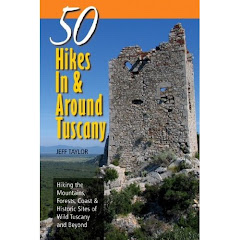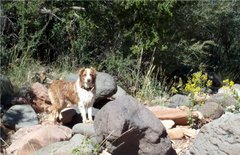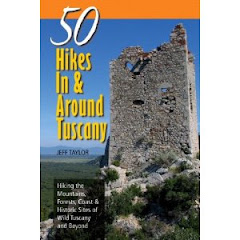Distance: 8.0 mile loop (12.9 km)
Elevation: 25 - 1150 feet (7 - 350 meters)
Difficulty: Moderate
Time of Year: September - May (way too hot in summer)
Located at the western edge of the Santa Monica Mountains National Recreation Area is Point Mugu State Park. This rugged, rocky, arid landscape contains some beautiful examples of the various chaparral types including coastal sage scrub, ceonothus-chamise shrublands, coast live oak/laurel sumac thickets, and riparian stands of sycamores and ash. In addition, there are some magnificent examples of the stalked giant coreopsis growing in the canyon bottom.
This hike takes you up a beautiful canyon past a waterfall, up through the riparian and shady shrub thickets, up onto the higher grassy slopes, and then up to the ridgetop providing spectacular views panoramic views of the Santa Monica and Santa Susana Mountains and across the beautiful blue waters of the Pacific Ocean over to the Channel Islands offshore.
Point Magu State Park is located about 17 miles west of Malibu and 17 miles east of Ventura off CA Hwy 1. Pull into the La Jolla Canyon day use parking area to access the trailhead.
The loop can be done in either direction. But, to use to the sun's direction to your advantage in the panoramic views, I recommend following the bottom of La Jolla Canyon (to main trail past the gate to the left) rather than the steep and exposed Ray Miller Trail to the right.
Near the beginning of the trail
The La Jolla Canyon trail starts by following above the sycamore-lined creek and in 0.8 miles arrives at the small waterfall. After crossing the creek, the trail continues following the canyon. Keep an eye out for plentiful poison oak along the trail, ticks dangling from overhanging grass, and a surprising number of very pesky large black mosquitoes. That potent triple combo can make this initial segment less than enjoyable.
The former pastureland known affectionately as "Tickville"
At 1.2 miles, a trail branches off to the left, but stay straight ahead. At 2.1 miles, the La Jolla Group Camp trail branches off also to the left. Based on my experience at this spot, you better have deet if you are going to camp here. For the loop, stay right and at 2.4 miles the trail emerges in an open grassland that was former pasture land. Here, the trail arrives at the "Overlook Fire Road". Get onto the fire road heading right and upslope. Soon there will be a 4 way intersection of fire roads, turn right continuing on the "Overlook Fire Road".
The view from the "Overlook Fire Road"
This fire road slowly climbs up the slope offering ever expanding panoramic views of the region. At the top of the ridge, you are now at 1150 feet in elevation with speactular views across all of the mountains and to the Channel Islands offshore. While the mosquito assault has diminished greatly, the are countless tiny and seemingly harmless flies that will cover your legs. The fire road continues along the ridgeline toward the sea. Watch for mountain bikers going in both directions on the fire road, especially on weekends.
Boney Mountain with Sycamore Canyon at its base
Because the sun has moved more to the west by the time you make it to this ridgeline, the lighting on the 2860 foot Boney Mountain Wilderness becomes more and more spectacular. Down at the bottom of the drainage is Sycamore Canyon, aptly named due to the large sycamores that line the bottom.
Notice the Channel Islands offshore?
As the fire road approaches the ocean's edge, there is the intersection with the Ray Miller Trail. If you continued on the fire road, it will descend down to the bottom of Sycamore Canyon and a parking area at the bottom. But, instead turn right onto the Ray Miller Trail.
The Ray Miller Trail is a winding 2.4 mile, 1000 foot descend through a beautiful and aromatic coastal sage scrub habitat, with nearly undescribable views of the ocean, Channel Islands, and coastline of the Santa Monica Mountains. You can even see way off in the distance the Santa Ana Mountains south of Los Angeles.
The trail's surface is quite good, despite the constant descent. Usually, I prefer the ascent the steeper sections and descend the more gradial routes to take the pressure off my knees. But, this is the rare case where in the hot mid-afternoon sun, I was glad I was going down this way. Also, the wildflowers in spring make this an absolutely incredible time to do this trail.


















































